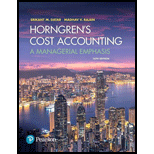
Concept explainers
Target costs, effect of process-design changes on service costs. Solar Energy Systems (SES) sells solar heating systems in residential areas of eastern Pennsylvania. A successful sale results in the homeowner purchasing a solar heating system and obtaining rebates, tax credits, and financing for which SES completes all the paperwork. The company has identified three major activities that drive the cost of selling heating systems: identifying new contacts (varies with the number of new contacts); traveling to and between appointments (varies with the number of miles driven); and preparing and filing rebates and tax forms (varies with the number of solar systems sold). Actual costs for each of these activities in 2016 and 2017 are:
| 2016 | 2017 | |
| Average cost per new contact | $ 8.00 | $ 7.00 |
| Travel cost per mile | 0.55 | 0.65 |
| Preparing and filing cost per new system | 275.00 | 250.00 |
After experiencing high costs in 2016. SES used value engineering to reduce the cost of selling solar heating systems. Managers at SES want to evaluate whether value engineering has succeeded in reducing the selling cost per sale by the targeted 8% in 2017.
Actual results for 2016 and 2017 for SES are:
| Actual Results for 2016 | Actual Results for 2017 | |
| Sales of heating systems | 175 | 188 |
| Number of new contacts | 225 | 240 |
| Miles driven | 1,900 | 1,750 |
- 1. Calculate the cost per sale in 2016.
Required
- 2. Calculate the cost per sale in 2017.
- 3. Did SES achieve the target cost per sale in 2017? Explain.
- 4. What challenges might managers at SES encounter in achieving the target cost and how might they overcome these challenges?
Want to see the full answer?
Check out a sample textbook solution
Chapter 13 Solutions
Horngren's Cost Accounting: A Managerial Emphasis (16th Edition)
- E14.10 (LO 1) (Information Related to Various Bond Issues) Pawnee Inc. has issued three types of debt on January 1, 2022, the start of the company's fiscal year. a. $10 million, 10-year, 13% unsecured bonds, interest payable quarterly. Bonds were priced to yield 12%. b. $25 million par of 10-year, zero-coupon bonds at a price to yield 12% per year. c. $15 million, 10-year, 10% mortgage bonds, interest payable annually to yield 12%. Instructions Prepare a schedule that identifies the following items for each bond: (1) maturity value, (2) number of interest periods over life of bond, (3) stated rate per each interest period, (4) effective-interest rate per each interest period, (5) payment amount per period, and (6) present value of bonds at date of issue. Hint: you don't need to prepare the amortization schedule to answer this question. Just a simple table is enough.arrow_forwardNeed correct answer of this question general Accountingarrow_forwardNeed help this questionarrow_forward
- Principles of Accounting Volume 2AccountingISBN:9781947172609Author:OpenStaxPublisher:OpenStax College
 Intermediate Accounting: Reporting And AnalysisAccountingISBN:9781337788281Author:James M. Wahlen, Jefferson P. Jones, Donald PagachPublisher:Cengage Learning
Intermediate Accounting: Reporting And AnalysisAccountingISBN:9781337788281Author:James M. Wahlen, Jefferson P. Jones, Donald PagachPublisher:Cengage Learning  Essentials of Business Analytics (MindTap Course ...StatisticsISBN:9781305627734Author:Jeffrey D. Camm, James J. Cochran, Michael J. Fry, Jeffrey W. Ohlmann, David R. AndersonPublisher:Cengage Learning
Essentials of Business Analytics (MindTap Course ...StatisticsISBN:9781305627734Author:Jeffrey D. Camm, James J. Cochran, Michael J. Fry, Jeffrey W. Ohlmann, David R. AndersonPublisher:Cengage Learning Managerial AccountingAccountingISBN:9781337912020Author:Carl Warren, Ph.d. Cma William B. TaylerPublisher:South-Western College Pub
Managerial AccountingAccountingISBN:9781337912020Author:Carl Warren, Ph.d. Cma William B. TaylerPublisher:South-Western College Pub Financial And Managerial AccountingAccountingISBN:9781337902663Author:WARREN, Carl S.Publisher:Cengage Learning,
Financial And Managerial AccountingAccountingISBN:9781337902663Author:WARREN, Carl S.Publisher:Cengage Learning,





